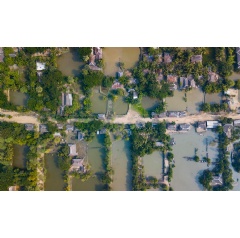COP30: Closing the gap

There’s a lot of talk about “the gap” in climate discussions. Essentially, the gap is the difference between what the world needs to do to meet the Paris Agreement goals and what countries have done or pledged to do so far.
In fact, it’s not so much one gap as several – with the main gaps being in mitigation, adaptation and finance.
What’s the mitigation gap, and why does it matter?Mitigation is about taking action to limit the levels of greenhouse gases in the atmosphere. For example, countries might phase out coal-fired power plants and invest in renewable energy like wind and solar, or improve energy efficiency in buildings and transport, or prevent deforestation. The mitigation gap is the difference between current emission reduction pledges and what’s needed to limit global warming to 1.5°C. And it’s a frighteningly big gap.
Existing policies and actions put the world on track for around 2.7°C of warming by the end of the century. Even if countries fulfilled all the pledges in their current climate plans (such as “nationally determined contributions” or NDCs under the Paris Agreement) we’d be looking at a likely 2.1°C of warming. The impacts for people and nature would be catastrophic.
In the lead up to and at COP30, countries will submit new or updated NDCs. It’s essential these are more ambitious in terms of emissions cuts, and that they cover all sectors and sources of emissions. Protecting and restoring high-carbon natural ecosystems, from tropical forests to seagrass beds, should also be a key part of countries’ climate plans.
But it’s not just about words – plans need to be put into action. Closing the mitigation gap requires rapid action to phase out fossil fuels, accelerate renewable energy and energy efficiency, and scale up nature-based climate solutions.
- WWF Climate Lead and Cop30 President: Heading to Brazil with optimism
- WWF at COP30: Find out more
- WWF’s Expectation Paper: Essential outcomes required from COP30
- The triple threat: Unpacking the gaps in global climate commitments
Even if we cut emissions fast and deep, worsening climate hazards – heatwaves, floods, storms and droughts – are inevitable. The adaptation gap refers to the difference between what communities need to stay safe from worsening climate impacts and the support and action currently available.
From infrastructure and early-warning systems to water management and food security, countries will need to invest in adaptation. But there’s a huge gap between what they need to do to provide climate resilience and what’s currently planned or funded.
Closing the adaptation gap is about protecting people and ecosystems now as well as preparing for the future. Countries need to strengthen adaptation planning and align it with their NDCs and national policies. A key area for COP30 is getting support to countries and communities that are most vulnerable to climate impacts.
Why is the finance gap such a big deal?Delivering on mitigation and adaptation plans will require huge investment. The finance gap refers to the shortfall between the climate finance needed and current investments in mitigation and adaptation. Developing countries – which generally bear least responsibility for climate change but face the greatest impacts – need more support from developed countries.
To close the finance gap, developed countries need to make good on existing pledges, and go much further – including by mobilizing private sector finance and new funding mechanisms. Hundreds of billions to trillions of dollars will be needed every year to invest in mitigation and adaptation and cover the costs of loss and damage from unavoidable climate impacts. While these are vast sums, the costs of inaction on climate change are estimated to be far greater in the long run.
How are mitigation, adaptation and finance gaps connected?These three gaps are deeply intertwined:
- Without sufficient mitigation (cutting emissions), we’ll face higher global warming and the consequent climate hazards. This means more investment in adaptation will be needed for the same level of climate resilience.
- Without sufficient investment in adaptation, vulnerable countries and communities face faster rising costs from worsening climate disasters.
- Without sufficient finance, ambitious mitigation and adaptation plans can’t be implemented. A lack of investment is much costlier in the long run.
COP30 is an opportunity to address all three together – and, crucially, to close the gap between ambition and action.
( Press Release Image: https://photos.webwire.com/prmedia/7/346026/346026-1.jpg )
WebWireID346026
This news content was configured by WebWire editorial staff. Linking is permitted.
News Release Distribution and Press Release Distribution Services Provided by WebWire.